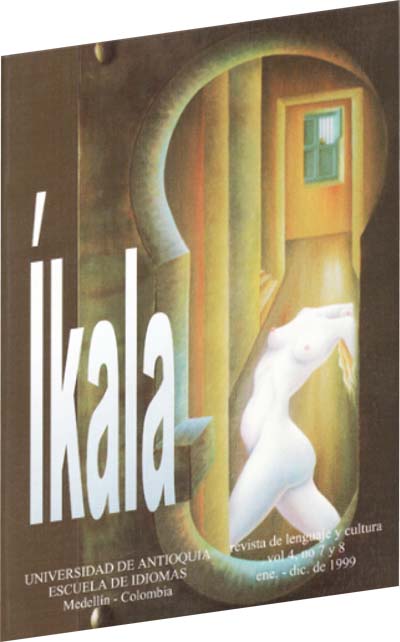Dès les modèles traductifs et les traductions modèles vers la traduction comme un modèle. Quelques implications pour les études traductologiques et l'enseignement de la traduction
DOI :
https://doi.org/10.17533/udea.ikala.8493Mots-clés :
histoire de la traduction, traduction comme processus, enseignement de la traduction, traduction postcolonialeRésumé
Avec le développement des sciences de la traduction, cette discipline a récemment acquis une nouvelle identité: c'est un processus et non plus un produit Les conséquences de cette nouvelle conception doivent être prises en compte dans l'élaboration de programmes de formation en traduction, tant au niveau des cursus qu'au niveau méthodologique. De plus, en la considérant d'une part métaphore et modèle à part entière, et d'autre part processus infini, démocratique et créatif, la qualité de son enseignement ne peut qu'en être enrichie.
Téléchargements
Références
S. BASSNETT, A. LEFEVERE, Constructing cultures, Multilingual Matters, Clevedon, England, 1998.
"Uber die verschieden Methoden des Ubcrsetzens" (1813), reprinted in Hans Joachim Storíng (ed), Das Problem des Ubersetzens, Darmstadt, 1969.
J. BEER (ed), Medievalrranslarars and theircrafl, Westc.m Michigan Universíty, Medieval lnstitute Publícations, 1989, p.2.
M. CRONIN, Translatlng lre/and. Translation, languages , culture, Cork University Press, 1996, p.6.
See in particular S. SI.MON, Gender In translation, Roullcdge, London, l996.
A. LEFEVERE, "Chinese and Western thinking on translation", in S. Bassneu, A. Lefevcre, Construeling cultures, op. cit., pp. 12-24.
R. JACQJEMOND, "Translatioo and cultural hegemony: The case of French-Arabic
Translation", in L. Venuti (ed.), Rethinlcing translation. Discourse, suhjectMry, ideology, Routledge, London, l992, pp. 139-58.
J. ABBOUSRI DALLAL, "The perils of occidentalism. How Arab novelists arcdriven to wrilc for Wcstcm readers", Times Lilerary Supplement (London), No. 4960, 24 April
, pp. 8-9.
L. VENUTI (ed.), Rethinlring translatwn. Discourse, subjecliviry, ideology, op. cit., introductíon, pp. 1•17, and the translaror’s invisibility. A historyoftron.slation, Routlcdgc, Loodon, l995.
H. GONCAL VES BARBOSA, "Transaltion: Brazil", in V. Smith(ed), EnyclopediooflAJín American Literalure; Fitzroy Dearborn Pubüshcrs, London, 1997, p. 798.
Cited by D. OERDES, '"l'ranslation: Spanish America", in V. Smith, op. cit., p. 800.
M. SAYERS PIIDEN, "Mario Vargas Llosa in English translation. A survey of translator reception", ldeas '92, Vol. 2/1, 1992,citedby O. Oerdes, in V. Smith, op. cit., p. 801 .
L. VENUTI, The scandals of translation, Roudcdcge, London, 1998, p. 48.
Op. cit., p. 49.
A. LEFEVERE, Translating literature. Practice and theory in a comparative literature context, Modern Language Association of America, New York, 1992, p. 7.
S. BASSNETT, Translation studies (revised edition), Routledge, London, 1991, p. l6.
J. P. VlNAY & J. DARBELNET (1958), Stylistique comparés du français et de l'anglais: méthode de traduction, Beauchemin,
Montreal, 1977; P. NEWMARK, A textbook of translation. Prentice Hall, New York 1987.
A. LEFEVERE, op. cit., p.8.
L. VENUTI, The scandals of translation, op. cit., p.21.
O. ROBINSON, Becoming a translator, Routledge, London, 1997, pp. l92ff.
J. CULLER, literary theory. A very short introduction, Oxford University Press, 1997, p. IS.
D. ROBINSON, op. cit., p.SI.
lbid, p.292.
S. PINKER. The language instinct. The new science of language and the mind, Allen Lane/ The Penguin Press, London, 1994.
L. VENUTI, The translator’s invisibility. A history of translation, op. cit.
T. NIRANJANA, Siting translation. History, post-structuralism and the colonial context, University of California Press, 1992, p. l.
L. VENUTI, The scandals of translation, op. cit., p. 10.
S. BUDICK, W. ISER (eds.), The translatability of cultures, Stanford University Press, 1996.
J. CLIFFORD, Routes. Travel and translation in the late twentieth century. Harvard University Press, 1997.
S. BASSNE1T, A. LEFEVERE, Constructing cultures, op. cit., p.137.
Theory of the earth, t79S
M. CRONIN, op. cit.
J. CLIFORD, op. cit.
E. CHEYFITZ, expanded edition, University Of Pennsylvania Press, 1997.
D. ROBINSON, Northem Illinois University Press, 1996.
J. ASSMANN, in S. Budick, W. Iser, The Translatability of Cultures, op. cit., pp. 25-36.
H. RAM, IN A. DlNGWAY, C. MAIDER (eds.), Between languages and cultures, University of Pittsburgh Press, 199S, pp. 199-222.
S. MASINOALE BBLL, ibid. pp. 51-74.
L. KARAMCHETI, ibidem, pp. 181 - 197.
L. VENUTI, Tire translator's invisibility. A history of translation, op. cit.
L. VENUTJ, The scandals of translation, op. cit., p. 11. The term "remainder", taken from Lecercle, refers to the "minor variables" lo a "major form" which dominates a language at a given time.
lbid. p.ll.
S. BASSNETT, A. LEFEVF.RE, Constructing cultures, op. cit. P. l.
For some interesting examples, see the two important articles: C. MAIER, "Towards a Theoretical practice for cross-cultural translation", and A. DINOWANEY AND C.
MAIER, "Translation as a method for cross-cultural teaching", both in A. Dingwaney, C. Maier (eds.), Between languages and cultures, op. cit, pp.21-38 and 303-319.
Téléchargements
Publié-e
Comment citer
Numéro
Rubrique
Licence
(c) Tous droits réservés Íkala, Revista de Lenguaje y Cultura 1999

Cette œuvre est sous licence Creative Commons Attribution - Pas d'Utilisation Commerciale - Partage dans les Mêmes Conditions 4.0 International.












